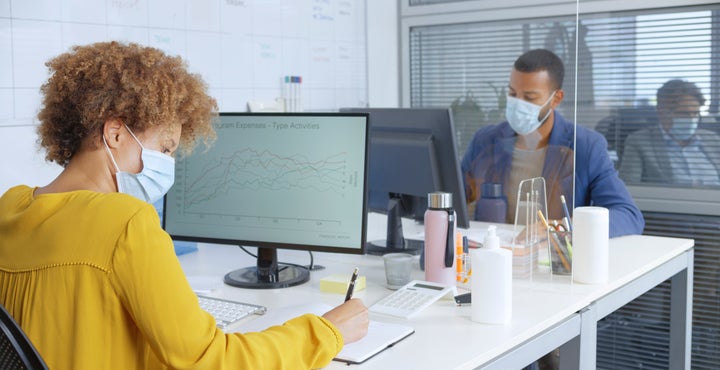Perspex screens, the type you might see in offices, restaurants or hair and beauty salons, don’t prevent the spread of Covid – and could increase transmissibility, officials have told ministers.
The draft Whitehall document said the transparent plastic screens are often “incorrectly positioned” and could make matters worse by “blocking airflow that helps disperse any virus droplets”. This is despite the fact “screens or barriers” are listed as “additional control measures” in government guidance for offices.
In response, the prime minister’s spokesperson said: “The Health and Safety Executive will keep its guidance under review based on the latest evidence, and should that evidence necessitate a change, it would be changed.”
So, have the screens been a waste of time for businesses that have invested in them? Perhaps. Dr Julian Tang, clinical virologist at the University of Leicester, explains: “Perspex screens only block large droplet ‘splatter’ expelled – e.g. during coughing or sneezing, which are too large to inhale anyway – but not the finer aerosols produced by talking and breathing that can float over or around these screens to be inhaled by those behind them – unless the screens extend from floor to ceiling and wall to wall.”

Dr Tang says the half-height perspex screens “can block air movement and mixing” which would dilute finer inhalable aerosols, but the specific circumstances may differ.
The screens could temporarily delay infectious aerosols entering your airspace if you’re sitting in a restaurant booth, for example, but if you’re there for a long enough time for the aerosols to disperse more widely within that airspace, they will not be useful after that point, he says.
“The time taken for this more general aerosol dispersal will depend on how many infected are in the restaurant, the type of ventilation present, and the movement of people as well as the presence of heat sources (which also includes people),” says Dr Tang. “If the windows are all open, the aerosol concentration drops dramatically very quickly – think of how fast the burnt toast smell disappears from your kitchen once you open the windows.
“Hence the importance of ventilation – which is far greater and more effective than the use of such Perspex screens – to reduce indoor virus transmission.”
Trisha Greenhalgh, professor of primary health care services at the University of Oxford agrees, adding that the “virus is airborne”, making ventilation is crucial.
“Anything that stops a through-draught will stop the virus from escaping,” she says. “The whole idea of plastic screens was predicated on a droplet model of transmission – they would stop people getting hit by the drops in other people’s coughs and sneezes. But as evidence has accumulated that the virus is airborne, it’s become clearer that the priority is to ensure good ventilation.”
Many scientists agree on this. Dr Bryan Bzdek, research fellow at Bristol Aerosol Research Centre, University of Bristol, says the plastic screens will only be useful when people are in “close, face-to-face contact”.
In this situation, the screen will prevent large droplets generated by one person from hitting the other person, he says. “These screens are not effective mitigations for transmission by aerosols, which simply follow the gas flow and therefore will move around the screen. A face covering is a significantly more protective and effective mitigation than any sort of screen in most situations.”
Some believe the screens still have a purpose as a control measure for the transmission of Covid, though.
Professor Paul Digard, chair of virology at the University of Edinburgh, says: “Do this simple thought experiment – you’re standing the other side of a counter from someone with Covid and they sneeze without getting a hand up in time. Would you rather there was a perspex screen in between you? It’s the same outcome if all they’re doing is talking, and even if they’re wearing a mask – it’s just that the situation starts with a lower baseline risk of transmission,” he says.
“There are other issues that affect how likely (or not) screens are to reduce virus transmission, but in my view, they are likely to be an effective measure.
“There might be some merit in argument over their blocking airflow and thus leading to higher local virus concentrations in some circumstances, but this would only really apply under conditions of poor ventilation and longer periods of exposure where virus transmission is occurring through aerosols.
“It’s important to remember that we still don’t know for sure what the balance of Covid transmission through aerosols, larger respiratory droplets and surface contamination is; screens will be very effective against the latter two modes, even if less so against aerosols.”
